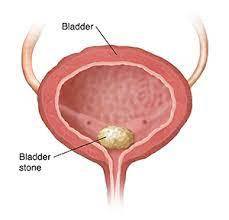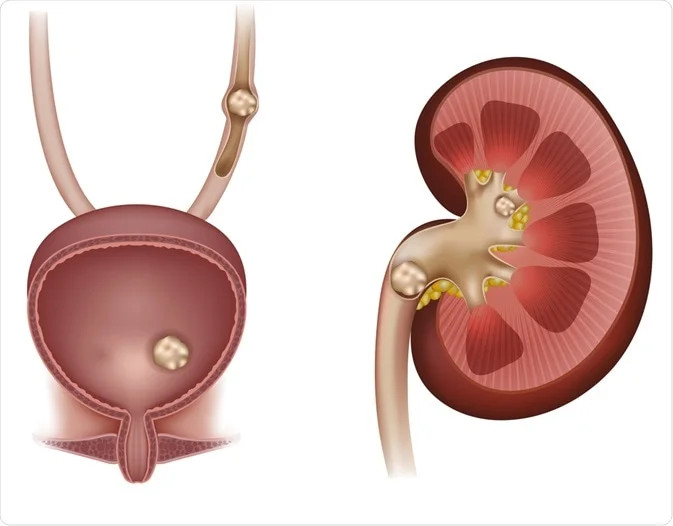Definition
Bladder stones, also known as vesicolithiasis, are urinary tract stones that form in the bladder. The bladder is an organ responsible for storing urine before it is expelled during urination. While bladder stones can occur in both children and females, they predominantly affect males.
Causes
Urine, produced by the kidneys, is a mixture of water and waste substances from the blood that have been filtered by the kidneys. When urine remains in the bladder for an extended period without being voided, these waste substances can precipitate and accumulate, forming crystals. Over time, these crystals can solidify and develop into bladder stones.
Bladder stones usually develop due to problems with urine flow, such as incomplete bladder emptying. This can happen in conditions like benign prostatic hyperplasia (BPH) or nerve abnormalities affecting bladder control. Nerve damage can result from spinal cord injuries or medical conditions affecting the nervous system, such as motor neuron disease or spina bifida. While BPH and nerve abnormalities are the primary causes of bladder stones, they can also occur in healthy individuals without urinary tract abnormalities.
In adults, the most common composition of bladder stones is uric acid, accounting for around 50% of cases. Other substances that can contribute to bladder stone formation include calcium oxalate, calcium phosphate, ammonium urate, cystine, and calcium-ammonium-magnesium phosphate (known as triple phosphate or struvite stones, often associated with urinary tract infections).
Risk factor
Several factors can increase the risk of developing bladder stones, including:
- Radiation therapy to the urinary tract
- Urinary tract surgery
- Urethral stricture a narrowing of the urethra that disrupts urinary flow from the bladder
- Bladder diverticula, pouches that protrude from the bladder wall, which can hinder complete bladder emptying. This condition can arise from birth or as a complication of infections or prostate enlargement.
- Urinary tract infections (UTIs), particularly in individuals prone to recurrent UTIs, such as those with spinal cord injuries or bladder abnormalities. UTIs can lead to the formation of struvite stones and calcium phosphate stones.
- Benign prostatic hyperplasia (BPH) in older men a common condition characterized by prostate enlargement, which can obstruct urinary flow and contribute to bladder stone formation.
- Cystocele a condition often seen in women, where the weakening of the bladder wall causes it to protrude into the vagina (bladder prolapse). This can obstruct urine flow from the bladder and may result from factors such as childbirth, heavy lifting, or constipation.
Bladder stones are rare in children compared to adults.
Symptoms
Bladder stones may not always produce specific symptoms and can remain asymptomatic if they are small enough to pass out with urine. However, larger bladder stones often cause symptoms as they can irritate the bladder wall and/or obstruct urinary flow. Common symptoms include:
- Presence of blood at the end of urination: Visible blood at the end of urination, along with a sudden cessation of urine flow, is a common sign associated with larger bladder stones.
- Lower abdominal pain: Intense lower abdominal pain may be experienced, with men possibly also feeling pain in the penis area.
- Weak urine flow: Bladder stones can impede urinary flow, resulting in a weakened stream.
- Painful urination or difficulty urinating: Pain during urination, or difficulty initiating or completing urination, may occur. The pain can vary in intensity and may be felt at the tip of the penis, scrotum, pelvis, or the perineal area (between the penis and anus).
- Increased frequency of urination: There may be a frequent urge to urinate, especially at night.
- Cloudy or dark-colored urine
- Swollen bladder: A swollen bladder may be palpable in the lower abdomen.
In children, bladder stones can lead to bedwetting, and boys may experience priapism, a persistent and painful erection that can last for several hours.
Diagnosis
To diagnose bladder stones, a doctor will typically conduct a comprehensive evaluation, including a medical interview and physical examination, to assess the patient's symptoms. If bladder stones are suspected, the doctor may order several diagnostic tests, such as:
- Blood Tests: These tests can detect any signs of infection in the bladder.
- Urine Analysis: Urine analysis aims to identify the presence of blood and signs of infection. Individuals with a history of kidney stones may require metabolic tests, including a 24-hour urine analysis, to assess risk factors for kidney stone formation and determine appropriate preventive therapy.
- Imaging: Given that the symptoms of bladder stones can be nonspecific and resemble those of other conditions, Imaging is typically necessary for diagnosis. X-rays are commonly used initially to detect stones, but some stones may not be visible on X-rays. Therefore, further imaging studies such as a CT scan or bladder ultrasound may be needed. It's important to note that a negative X-ray result does not definitively rule out the presence of stones.
- Cystoscopy: This procedure involves inserting a fiber-optic tube equipped with a light and camera into the urethra and up to the bladder. The doctor can observe the inside of the bladder via a monitor, allowing for direct visualization of any stones present.
Management
The treatment of bladder stones depends on their size. Small stones may pass out easily, but larger stones can become lodged in the neck of the bladder, impeding urine flow.
The management of bladder stones typically involves medication therapy and surgery:
- Medications: Bladder stone dissolution, particularly for uric acid stones, may be attempted with the administration of agents that regulate urine pH.
- Surgery: Surgery is often necessary to address bladder stones. The most common procedure is cystolitholapaxy, where a thin tube (cystoscope) with a camera at its tip is inserted into the bladder to locate the stones. Stone-breaking devices, lasers, or ultrasound are then used to break the stones before they are removed from the urinary tract. Most stones can be effectively treated with endoscopic surgery.
In addition to stone therapy, addressing the underlying causes of stone formation is essential to prevent the recurrence of stones in the future.
Complications
Untreated bladder stones can lead to damage to the urinary tract, recurrent stone formation, and urinary tract infections.
Prevention
If you've experienced bladder stones before, you're at risk of recurrence. Fortunately, there are several steps you can take to prevent this:
- Stay hydrated: Aim to drink 2-3 liters of fluids daily to reduce urine concentration and deter stone formation.
- Empty your bladder regularly: Avoid holding urine and make a habit of emptying your bladder regularly.
- Try voiding again: If you feel you haven't completely emptied your bladder when urinating, attempt to void again within 10-20 seconds to ensure thorough emptying.
- Avoid constipation: Incorporate fiber-rich foods like vegetables and fruits into your diet to prevent constipation.
When to see a doctor?
You should consult a doctor if you experience symptoms of bladder stones, especially if there is persistent abdominal pain, increased frequency of urination, or blood in the urine. While these symptoms are not always indicative of bladder stones, they certainly warrant further examination.
Looking for more information about other diseases? Click here!
- dr Anita Larasati Priyono
Leslie, S., Sajjad, H., & Murphy, P. (2022). Bladder Stones. Retrieved 24 June 2022, from https://www.ncbi.nlm.nih.gov/books/NBK441944/
Bladder stones. (2022). Retrieved 24 June 2022, from https://www.nhs.uk/conditions/bladder-stones/
Bladder stones - Diagnosis and treatment - Mayo Clinic. (2022). Retrieved 24 June 2022, from https://www.mayoclinic.org/diseases-conditions/bladder-stones/diagnosis-treatment/drc-20354345











